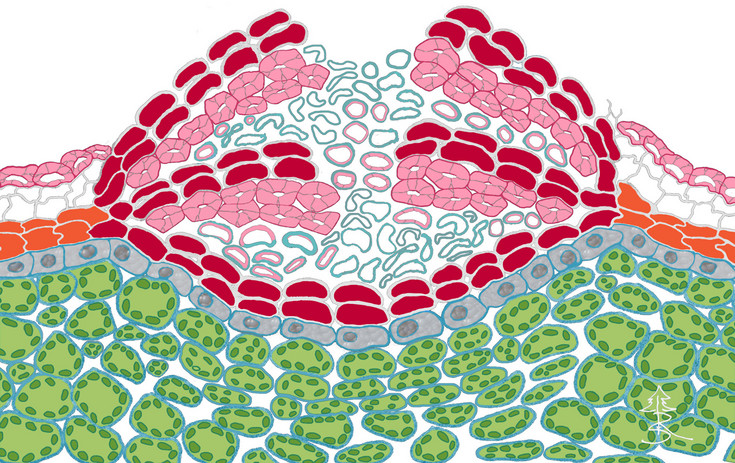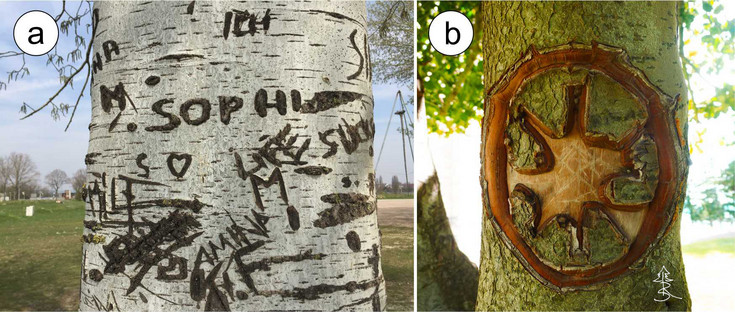SMART BARK: Unraveling the Role of Lenticels for Tree Health and Survival
Tree bark is an amour against wounding, dehydration, heat, UV radiation and pests; however, it is not a hermetic barrier to the outside. The inner bark consists merely of living cells, the outer bark, which protects the tree stem and its productive tissues, consists of dead tissues containing variable amounts of cork. When multiple protective layers are present, the collective term for these is rhytidome.
The living part of bark stores and transports sugar, which is produced by photosynthesis in the leaves but also in the bark. For this reason, not only leaves are green, but also a thin tissue layer in the living bark. Prerequisite for the production of sugar is carbon dioxide and all living tissues need oxygen for respiration. The bark thus needs aeration and this important task is fulfilled by the lenticels, also called cork pores (Fig. 1).

Fig. 1. Variability in lenticel size and shape. (A) Lime tree (Tilia sp.). (B) Black elder (Sambcus nigra). (C) Paper birch (Betula papyrifera). (D) Tibetan cherry (Prunus serrula). (E) Silver poplar (Populus alba) with very big rhomboid lenticels. - Scale bar = 100 mm. (Photos: Sabine Rosner, Rosner and Morris 2022)
Lenticels are tissue regions containing many tiny air-filled tunnels that connect stems, branches and roots to the atmosphere. In some species, such as in cherry trees, they are quite prominent and can be easily recognized (Fig. 1). The dark, fine pores in cork closures, which are produced from the bark of cork oak, are the small air tunnels of lenticels. The connection to the atmosphere via the lenticels presents a dilemma for the tree, however, because water vapor can also evaporate through the small tunnels. In leaves, water loss is controlled by the stomata, i.e. other pores, which differ to lenticels in that the opening and closing is regulated by a pair of living cells, on either side, called guard cells. Where we have extensive knowledge of the opening and closing mechanisms of stomata, we lack such knowledge for lenticels because their design is much more complex than that of stomata (Fig. 2).

Fig. 2. Anatomical design of a Norway spruce (Picea abies L. KARST) lenticel (Sketch: Sabine Rosner)
The aim of the project is to unravel the role of lenticels for tree health and survival. In a first step, the lenticel design of 180 different tree species will be analyzed. The size, shape and anatomy of lenticels differ tremendously among tree species and a characterization thereof will give hints on potential closing mechanisms and bark porosity. In a next step, seasonal differences in the permeability of the bark for water vapor will be investigated in selected tree species, because lenticels produce every year new tissue layers. A higher permeability in early summer could explain the increased sensitivity for drought during this season. The permeability of the outer bark for water vapor under the impact of an experimental early summer drought will be thereafter measured.

Fig. 3. Vandalism on tree bark in Vienna, Austria (a) and in San Carlos di Bariloche, Argentina (b) (Photos: Sabine Rosner)
Within the project, the role of lenticels for wound healing (Fig. 3) will be investigated as well. The production of wound tissue demands sugar, which can be produced locally in the bark, whereby newly formed lenticels (wound lenticels) provide carbon dioxide and oxygen support. The results of the project should help to find tree species that optimized water loss regulation of the bark and we intend to create awareness for the multifunctional role of lenticels for tree survival.
Literature
Rosner S., Morris H. (2022) Breathing life into trees: The physiological and biomechanical functions of lenticels. IAWA Journal 43(3): 234-262.
https://doi.org/10.1163/22941932-bja10090
Team
Hugh Morris (external URL)
Anna Lintunen (external URL)
Andreas Helmersson (external URL)
